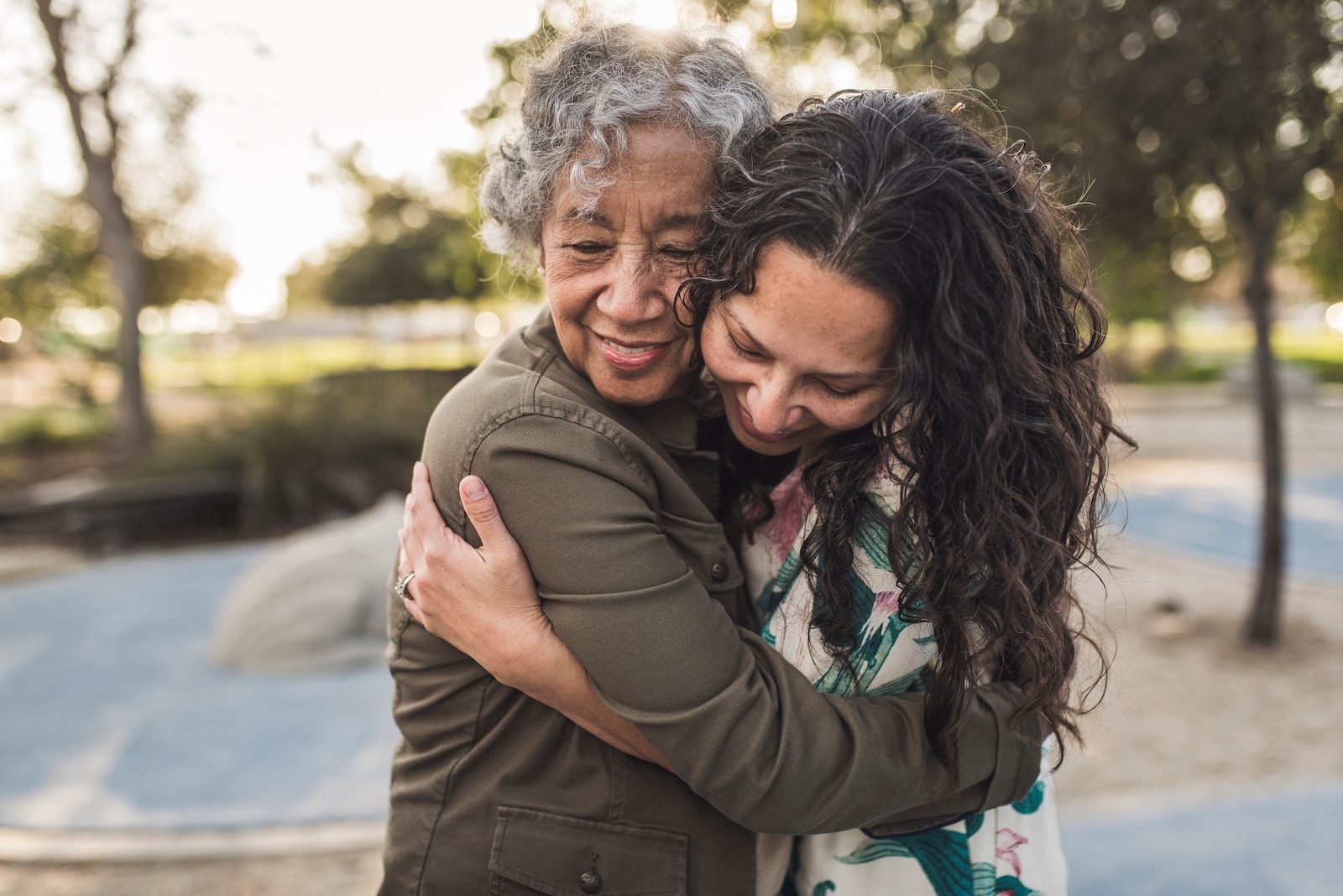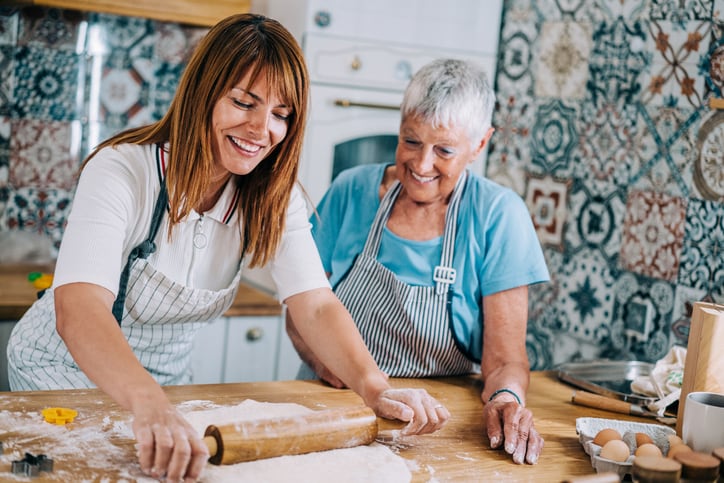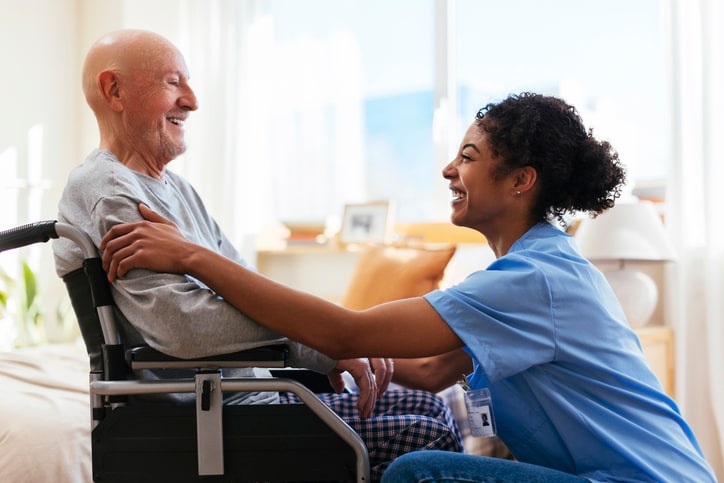If you happen to care for an aging loved one and don’t necessarily consider yourself a caregiver, you’re not alone. Despite the fact that 43% of adults are caregivers (for either someone under 18 or someone over 18), 50% of them don’t identify with the word, according to ARCHANGELS, a national movement and platform dedicated to reframing how caregivers are seen, honored and supported.
“Part of that is confusion — a caregiver is a doctor or a nurse,” says Alexandra Drane, co-founder and CEO ARCHANGELS. “For many reasons, it’s not a term that resonates.” For instance, in certain communities, such as the Hispanic and Latinx population, people think of themselves as doing the work any child of an aging adult would, points out Drane. Others believe that caring for others is something you naturally do as a “decent human being” or as a gift to someone who once cared for you.
But ultimately, being an unpaid caregiver is a job you deserve credit for, says Drane. And labeling your work is a step toward recognizing — and contending — with the stressors you likely face as a caregiver. Here, Drane explains why it’s crucial to embrace the term, how to own the challenges you’re facing as well as top coping tips and tricks.
Why it’s so important to label yourself as a caregiver
Being an unpaid caregiver is one of the most beautiful things any of us will ever do, acknowledges Drane. But it’s because unpaid caregivers are so invested in caring for their older loved one that their stress is so high. And, she points out, only by acknowledging both sides of the coin can you find the support you deserve.
At the same time, according to Drane, identifying yourself as a caregiver allows you to:
- Get credit for it.
- Gain support from your friends.
- Have language for what you’re going through.
- Seek out supportive resources.
For example, by labeling yourself as a caregiver, you can more readily navigate to resources like ARCHANGELS’ Caregiver Intensity Score tool, which will give you the language to describe how much stress you’re currently facing — red is the most, yellow is a moderate level, and green is the least — and inspire you to ask for what you need, based on your responses.
For instance, if you find that the main factor driving your intensity is that you have no time for yourself, you might ask your friends and family to sit with your aging loved one or hire respite care or a companion caregiver, says Drane. If you’re having trouble navigating benefits, you can find insurance agents and counselors who can help you with that.
Another example in which self-identification is useful: According to the National Alliance for Caregiving and AARP, 70% of caregivers who work outside the home suffer work-related difficulties due to their dual roles. By labeling yourself as a caregiver, you can identify the skills you’ve acquired in that role that belong on your resume, such as:
- Providing money management.
- Executing project management.
- Navigating financial assistance.
- Tackling legal aid.
- Finding creative solutions for complex problems.
- Working with others to reach a specific goal.
- Organizing a team of people to complete tasks.
- Managing complex situations.
- Coordinating difficult schedules, et al.
(Not sure where to begin? ARCHANGELS offers a tool called Skill Builder that will help you turn those skills into job qualifications.)
“One in four caregivers is a millennial, and one in five is Gen Z. The younger you are, the lonelier you are in your role — and the less likely you are to realize you’re in that role.”
— Alexandra Drane, co-founder and CEO ARCHANGELS
Join Care for free
How to ease your stress as a caregiver
Once you’ve identified yourself as a caregiver, Drane recommends doing the following to better cope with the stress and isolation you feel as a result of your role.
Share your experience
Tell your story to as many people as you can, encourages Drane. After all, most caregivers believe they’re alone, she points out.
“One in four caregivers is a millennial, and one in five is Gen Z,” says Drane. “The younger you are, the lonelier you are in your role — and the less likely you are to realize you’re in that role.”
That said, if people can share their experiences more, it allows someone else the ability to see themselves reflected in it, she notes. And feeling less alone can reduce a caregiver’s stress significantly.
Trade tips
By sharing your story, you then open the door to trading helpful tips. Drane recalls hearing from a caregiver who had a parent with dementia. “They were wandering, and they would get out of bed in the middle of the night. The caregiver was not sleeping, because they were always so afraid that their mom would wander out of the house. So they put bells on the bed. And then when Mom got up, the bells would wake the caregiver, and they could get their parent back to sleep. Sharing tips like this with your peers is really important.”
Practice self-compassion as much as possible
All too often, unpaid caregivers might get down on themselves for coming up short in the self-care department. They’ll beat themselves up for starting an anti-anxiety medication, for their health going south, for drinking too much or for gaining weight. “And they think it’s because they’re just failing at being this perfect human,” says Drane.
But by identifying yourself as a caregiver and noting your Intensity Score, you can connect the dots between your job and coping mechanisms. “If you can name it, that feels better right out of the gate,” says Drane.
You’ll also want to do your best to practice self-compassion. “If you have this job, and it’s hard, do not add on top of it that you’re angry at yourself for not doing the job perfectly,” she emphasizes. “You’re doing the best you can.”
“If you have this job, and it’s hard, do not add on top of it that you’re angry at yourself for not doing the job perfectly.”
— Alexandra Drane, co-founder and CEO ARCHANGELS
And when your Intensity Score comes down to yellow or green, perhaps you could sleep an extra hour, eat a little healthier, says Drane.
Read more:
Have a “red phone”
If you note via your Intensity Score that you’re in the red, you need to know who you are going to call, says Drane. “You should have an array of people you’re gonna call or text — whatever channel works for you,” she notes.
These are people to whom you can let off steam in moments you feel you might combust. You might connect with a caregiver navigator or social worker who can help you problem solve and address an acute situation with your aging loved one.
Drane recalls hearing from her dad’s paid caregiver early in the pandemic. “She said, ‘We’re standing outside of the emergency room. I think your father’s having a heart attack. We’re going in,’” she remembers. “I literally stopped being able to breathe. I had no ability to process anything.” That’s when she called her “red phone” friend, explained she had forgotten everything she was supposed to do in a moment like this and the friend coached her through it.
Why it’s crucial to support other caregivers as well
Drane encourages caregivers who’ve gone through the above steps and “put on their air mask” to do what they can to support their fellow caregivers. “There’s this beautiful thing we call, ‘You give a lift, you get a lift,’” she explains. “If you do something kind for someone, you actually feel better yourself.”
Not only will you benefit individually, but by supporting other caregivers, you can normalize your work and eliminate stigma, says Drane. “Ultimately, I do believe that the country is going to get to a place where companies compete to be the best employer for caregivers and give people credit for the work that they’re doing,” she notes. “And that starts with each of us doing what we can to see ourselves in that role and see someone else in that role too.”



